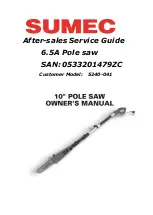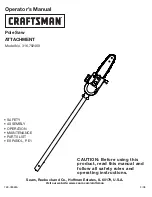
14
DO’S AND DON’TS FOR BLADES
WET CUT BLADES
DO'S
•
Inspect blades daily for cracks or uneven wear.
•
Always use appropriate blade for material being cut.
•
Inspect arbor shaft for uneven wear before mounting blade.
•
Always use blades with the correct arbor shaft size.
•
Ensure that blade is mounted in the correct direction.
•
Secure the blade to the arbor with a wrench.
•
Use proper safety equipment when operating the saw.
•
Periodically check the blade for cracks or bond fatigue.
•
Always have a continuous flow of water on both sides of blade.
DON'TS
•
Do not operate the saw without safety guards in position.
•
Do not operate the saw with blades larger than Ø 16" (400 mm)
•
Do not cut dry with blades marked "Use Wet".
•
Do not exceed manufacturer's recommended maximum RPM.
•
Do not force blade into material let blade cut at its own speed.
DRY CUT BLADES
DO'S
•
In addition to the following, always follow wet recommendations.
•
Use appropriate blade for material being cut.
•
Inspect segment blades for segment cracking or loss.
•
Do not use damaged blades.
•
Use proper safety equipment when operating the saw.
DON'TS
•
In addition to the following, always follow wet recommendations.
•
Do not make long cuts with dry blades--allow them to air cool periodically.
•
Do not use the edge or side of blade to cut or grind.
•
Do not attempt to cut a radius or curve.
•
Do not cut too deep or too fast into the material.
•
Do not cut any material not recommended by blade manufacturer.
Summary of Contents for TBE400
Page 1: ...Operating Instructions TBE400 Index 001 10999936 en 04 01 2022...
Page 12: ...12 FOLDING LEGS...
Page 24: ...24...
Page 26: ...26...
Page 31: ...31...















































